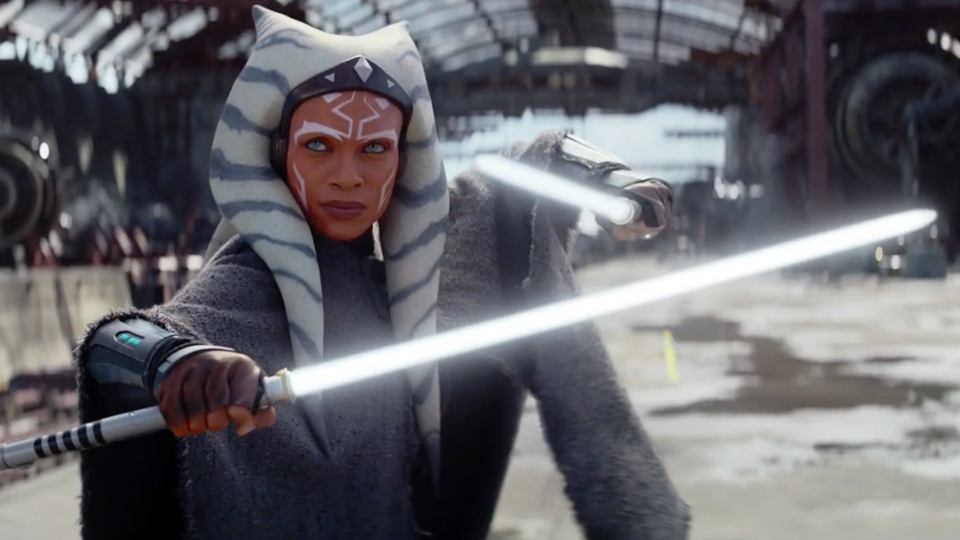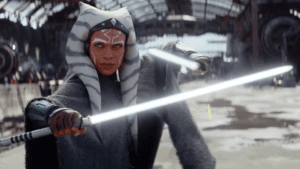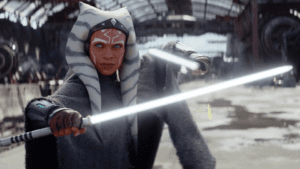Summary
Ahsoka delivers on its mandate to feel like a live-action continuation of Rebels, even if it’s a little safe in its presentation and
This review of the Disney+ series Ahsoka Season 1 does not contain spoilers.
Disney+ have been making a tremendous fuss about their new Star Wars miniseries Ahsoka and for seemingly good reason. It’s nothing to do with quality. The show is, at least after two episodes, mostly fine, and of roughly commensurate quality with other recent small-screen offerings in the franchise, like the third season of The Mandalorian and Obi-Wan Kenobi.
It’s more to do with a fan’s-eye view of the broader continuity, which hasn’t exactly been lavished with praise since the House of Mouse took over. Andor, by far the best piece of Star Wars television, was adored by critics but watched by only a small-ish, very dedicated subsection of die-hard fans. It was a political thriller about how rebellion foments under tyranny, with nary a space wizard in sight.
Ahsoka, on the other hand, is the spiritual follow-up to the beloved animated series Rebels, following characters introduced and developed through the similarly adored series The Clone Wars. It’s essentially a multi-million-dollar fan project, with Dave Filoni, who created the series and directed several of its episodes, being famously a fan above and beyond anything else.
Ahsoka Season 1 review and plot summary
This gives Ahsoka a very specific mandate to hit certain beats. It’s a continuation of the characters and plot of Rebels, specifically the disappearance of Ezra Bridger and Grand Admiral Thrawn, but it’s also its own thing, so it’s setting up a very classic master/apprentice dynamic – a couple, actually – to give the season some shape. It feels very comforting, and sometimes exciting, but also regrettably safe and on-trend in a way that something like Andor didn’t.
Nevertheless, the first two episodes pick up after Ahsoka’s live-action debut in The Mandalorian Season 2. She’s on the hunt for a map that’ll reveal the location of Grand Admiral Thrawn, who as we learned in The Mandalorian Season 3 Episode 7 is at the head of an Imperial Remnant Shadow Council and heavily involved in Project Necromancer, a plot to – we assume – clone Palpatine as seen in The Rise of Skywalker, tying all of Disney’s on-going Star Wars shows (including The Bad Batch) into the same overarching story.
Thrawn and co. are, needless to say, a threat to the nascent New Republic, primarily represented here through Hera Syndulla (Mary Elizabeth Winstead), now a General. When Ahsoka Tano (Rosario Dawson) finds the map, she needs the artistic aptitude of her lapsed Mandalorian protégé, Sabine Wren (Natasha Liu Bordizzo), to decipher it, bringing the three of them back together for the first time since Rebels with a lot of interpersonal baggage having amassed in the interim.
Also on the hunt for the map is Morgan Elsbeth (Diana Lee Inosanto), who is at least partially related to the Witches of Dathomir, and her cronies, who include a cadre of HK assassin droids, former Jedi Baylan Skoll (Ray Stevenson) and his apprentice, Shin Hati (Ivanna Sakhno), and a masked Inquisitor known as Marrok (played by stuntman Paul “Diddy” Darnell) who people are already speculating might be Ezra, otherwise seen only in holo-form played by Eman Esfandi and watched by a wistful Sabine.
Is Ahsoka good or bad?
The obvious problem with all this is that it’s basically impossible for a casual viewer to jump in and have any idea what’s going on. Filoni and Jon Favreau, who’s an executive producer and clear creative influence here, have been tasked with stewarding a multi-media storytelling initiative that has become so dense now that it’s essentially impenetrable for anyone who won’t get a kick out of a mural specifically designed to look like a frame from Rebels.
This means that most of the storytelling expects a degree of familiarity with the material you might not have and leans against various tropes and visual signifiers to do a lot of the heavy lifting. It communicates in shorthand, essentially. Here’s the lightsaber fight, here’s the chase sequence, here’s the visual metaphor for the old gang getting back together, and so on, and so forth. It often wheels out a comedy droid, the fan-favorite Huyang (voiced by David Tennant), to use the guise of “logical” dialogue to basically force characters to be explicit about their feelings and headspace.
This is a use of formula and nostalgia that people won’t like, but it’s also worth mentioning that it’s very competently done and doesn’t include anything as egregiously cynical as how Baby Yoda was used in the early days of The Mandalorian. It’s a beautiful show – a slightly washed-out quality notwithstanding – that has a nice sense of scale and grounded-feeling action, obviously embellished by CGI but not overwhelmingly cheap or fake-looking.
It feels, and you’ll forgive me for this, very much like Star Wars.
Is Ahsoka worth watching?
Ahsoka is a guaranteed hit and will sell itself to its intended demographic without any help from me, but thus far – and it’s admittedly early days yet – the hype seems fairly warranted. It’s a faithful continuation of The Clone Wars and Rebels in live-action that feels very true to the things people love about this universe and these characters.
What did you think of Ahsoka Season 1? Comment below.
You can watch this series with a subscription to Disney+.




